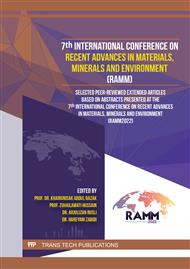[1]
N. Abdul Rahman, A. Albania Linus, E.E. Jihed, U. Jata, N.K.M.F. Kumar, A. Philip, A. Yassin, A. Parabi, Experimental Studies on Continuous Electrocoagulation Treatment of Peat Water in Sarawak with Copper Electrodes, Int. J. Integr. Eng. 13 (2021) 168–176.
DOI: 10.1088/1757-899x/778/1/012126
Google Scholar
[2]
N. Abdul Rahman, C. Jose Jol, A. Albania Linus, V. Ismail, Emerging Application of Electrocoagulation for Tropical Peat Water Treatment: A Review, Chem. Eng. Process. - Process Intensif. 165 (2021) 108449.
DOI: 10.1016/j.cep.2021.108449
Google Scholar
[3]
N. Abdul Rahman, N.A. Tomiran, A.H. Hashim, Batch electrocoagulation treatment of peat water in Sarawak with galvanized iron electrodes, Mater. Sci. Forum. 997 MSF (2020) 127–138.
DOI: 10.4028/www.scientific.net/msf.997.127
Google Scholar
[4]
I.A. Afip, K. Jusoff, Properties of a tropical sapric peat soil in sarawak, Malaysian J. Soil Sci. 23 (2019) 1–12.
Google Scholar
[5]
B. Al Aji, Y. Yavuz, A.S. Koparal, Electrocoagulation of heavy metals containing model wastewater using monopolar iron electrodes, Sep. Purif. Technol. 86 (2012) 248–254.
DOI: 10.1016/j.seppur.2011.11.011
Google Scholar
[6]
A.A. Al-Raad, M.M. Hanafiah, A.S. Naje, M.A. Ajeel, A.O. Basheer, T.A. Aljayashi, M.E. Toriman, Treatment of saline water using electrocoagulation with combined electrical connection of electrodes, Processes. 7 (2019).
DOI: 10.3390/pr7050242
Google Scholar
[7]
F. Ali, D.L. Lestari, M.D. Putri, Peat Water Treatment as an Alternative for Raw water in Peatlands Area, IOP Conf. Ser. Mater. Sci. Eng. 1144 (2021) 012052.
DOI: 10.1088/1757-899x/1144/1/012052
Google Scholar
[8]
K. Brahmi, W. Bouguerra, B. Hamrouni, E. Elaloui, M. Loungou, Z. Tlili, Investigation of electrocoagulation reactor design parameters effect on the removal of cadmium from synthetic and phosphate industrial wastewater, Arab. J. Chem. 12 (2019) 1848–1859.
DOI: 10.1080/19443994.2015.1024940
Google Scholar
[9]
O.T. Can, M. Bayramoglu, The effect of process conditions on the treatment of benzoquinone solution by electrocoagulation, J. Hazard. Mater. 173 (2010) 731–736.
DOI: 10.1016/j.jhazmat.2009.08.146
Google Scholar
[10]
G. Chen, X. Chen, P.L. Yue, Electrocoagulation and Electroflotation of Restaurant Wastewater, J. Environ. Eng. 126 (2000) 858–863.
DOI: 10.1061/(asce)0733-9372(2000)126:9(858)
Google Scholar
[11]
Department of Environment, Environmental Quality Act report, Ministry of Science, Technology and the Environment, Putrajaya, Malaysia, 2017.
Google Scholar
[12]
Department of Irrigation and Drainage, Resource Centre - Peat Swamp Development, (2017).
Google Scholar
[13]
A. El-Shazly, A.A. Al-Zahrani, Y.A. Alhamed, Kinetics and Performance Analysis of Batch Electrocoagulation Unit Used for the Removal of a Mixture of Phosphate and Nitrate Ions from Industrial Effluents, J. Electrochem. Sci. 8 (2013) 3176–3185.
Google Scholar
[14]
M.M. Emamjomeh, M. Sivakumar, Review of pollutants removed by electrocoagulation and electrocoagulation/flotation processes, J. Environ. Manage. 90 (2009) 1663–1679.
DOI: 10.1016/j.jenvman.2008.12.011
Google Scholar
[15]
F.U. Kac, M. Kobya, E. Gengec, Removal of humic acid by fixed-bed electrocoagulation reactor: Studies on modelling, adsorption kinetics and HPSEC analyses, J. Electroanal. Chem. 804 (2017) 199–211.
DOI: 10.1016/j.jelechem.2017.10.009
Google Scholar
[16]
S.U. Khan, I.H. Farooqi, M. Usman, F. Basheer, Energy efficient rapid removal of arsenic in an electrocoagulation reactor with hybrid fe/al electrodes: Process optimization using ccd and kinetic modeling, Water (Switzerland). 12 (2020) 1–13.
DOI: 10.3390/w12102876
Google Scholar
[17]
K.T. Kin, H.S. Tang, S.F. Chan, S. Raghavan, S. Martinez, Treatment of chemical-mechanical planarization wastes by electrocoagulation/electro-fenton method, IEEE Trans. Semicond. Manuf. 19 (2006) 208–215.
DOI: 10.1109/tsm.2006.873511
Google Scholar
[18]
V. Kuokkanen, Utilization of Electrocoagulation for Water and Wastewater Treatment and Nutrient Recovery, University of Oulu, 2016.
Google Scholar
[19]
V. Kuokkanen, T. Kuokkanen, J. Ramo, U. Lassi, Electrocoagulation treatment of peat bog drainage water containing humic substances, Water Res. 79 (2015) 79–87.
DOI: 10.1016/j.watres.2015.04.029
Google Scholar
[20]
M. Mamelkina, Treatment of mining waters by electrocoagulation, Lappeenranta-Lahti University of Technology LUT, 2020.
Google Scholar
[21]
L. Melling, H. Ryusuke, O. Mitsuru, Sustainable agriculture development on tropical peatland, 14-21 August, Thailand., 2002.
Google Scholar
[22]
H. Moayedi, M. Mosallanezhad, Physico-Chemical and Shrinkage Properties of Highly Organic Soil Treated with Non-traditional Additives, Geotech. Geol. Eng. 35 (2017) 1409–1419.
DOI: 10.1007/s10706-017-0184-1
Google Scholar
[23]
M.Y.A. Mollah, P. Morkovsky, J.A.G. Gomes, M. Kesmez, J. Parga, D.L. Cocke, Fundamentals, present and future perspectives of electrocoagulation, J. Hazard. Mater. 114 (2004) 199–210.
DOI: 10.1016/j.jhazmat.2004.08.009
Google Scholar
[24]
D.T. Moussa, M.H. El-Naas, M. Nasser, M.J. Al-Marri, A comprehensive review of electrocoagulation for water treatment: Potentials and challenges, J. Environ. Manage. 186 (2017) 24–41.
DOI: 10.1016/j.jenvman.2016.10.032
Google Scholar
[25]
A.A. Mutalib, J.S. Lim, M.H. Wong, L. Koovai, Characterisation, Distribution and Utilization of Peat in Malaysia, Tropical Peat, in: Int. Symp. Trop. Peatl., Kuching, Sarawak, Malaysia, 1991: p.7–16.
Google Scholar
[26]
B. Nvs, P.L. Saranya, Water pollutants monitoring based on Internet of Things, in: Inorg. Pollut. Water, 2020: p.371–397.
DOI: 10.1016/b978-0-12-818965-8.00018-4
Google Scholar
[27]
N.A. Rahman, C. Jose Jol, A. Albania Linus, F.L. Dampam, N.S. Abdul Jalal, N. Baharudin, W.W.S. Wan Borhan, Continuous electrocoagulation treatment of Borneo tropical brackish peat water from palm oil plantation region for domestic consumption in rural coastal areas, Chem. Eng. Process. - Process Intensif. 176 (2022) 108967.
DOI: 10.1016/j.cep.2022.108967
Google Scholar
[28]
Rusdianasari, Y. Bow, T. Dewi, Peat Water Treatment by Electrocoagulation using Aluminium Electrodes, IOP Conf. Ser. Earth Environ. Sci. 258 (2019).
DOI: 10.1088/1755-1315/258/1/012013
Google Scholar
[29]
N.M. Sa'don, A.R. Abdul Karim, W. Jaol, W.H. Wan Lili, Sarawak Peat Characteristics and Heat Treatment, UNIMAS E-Journal Civ. Eng. Sarawak. 5 (2015) 6–12.
DOI: 10.33736/jcest.139.2014
Google Scholar
[30]
E. Sakarinen, Humic acid removal by chemical coagulation, electrocoagulation and ultrafiltration, Arcada University of Applied Sciences, 2016.
Google Scholar
[31]
H. Singh, B.K. Mishra, Assessment of kinetics behavior of electrocoagulation process for the removal of suspended solids and metals from synthetic water, Environ. Eng. Res. 22 (2017) 141–148.
DOI: 10.4491/eer.2016.029
Google Scholar
[32]
T.C. Whitmore, A Vegetation Map of Malesia at Scale 1:5 Million, J. Biogeogr. 11 (1984) 461–471.
Google Scholar



